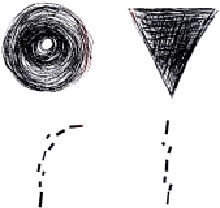Graphics Reference
In-Depth Information
mode, or modalities, to use. Among these are the evocative, emotional qualities of the
project's content; the number of different modes needed to differentiate specific mes-
sages; the expectations of the viewing audience for certain image experiences over oth-
ers, because of their demographic makeup or the social and historical context of the pro-
ject's content; and production issues, including such technicalities as budget, lead time,
and fabrication concerns. How far from its “natural” state the image gets (how much the
“pure” depiction of the subject gets altered by the designer) is described as how “me-
diated” it is. The level of an image's mediation can be evaluated in a couple of ways.
First, it can be considered in terms of its physical expression, or how it's made; for ex-
ample, a realistic drawing shows a greater level of mediation than a photograph of the
same subject. Second, an image's level of mediation can be considered in how complex
the messaging in the image is—a somewhat literal drawing of an image is less mediated
than a highly contrived photograph or collage. The way an image refers to its subject
is also an aspect of its form that must be considered by the designer, who might choose
to represent, or signify, particular subjects by using images that are realistic or repres-
entational but not pictures of the subject itself. This kind of image is called an “index”
and refers to its subject through association; an image of an egg, for example, “indexes”
a bird.
SYMBOLS ARE
highly mediated forms of image, drawing on common understanding and cultural
contexts that elevate them beyond mere representation. Consider these two sets of symbols, used
as signage to indicate which restroom to use.
Art: Tecaji
Slovenia
Real, Unreal, and Otherwise
Media and Methods
Presentation Options
Content and Concept










